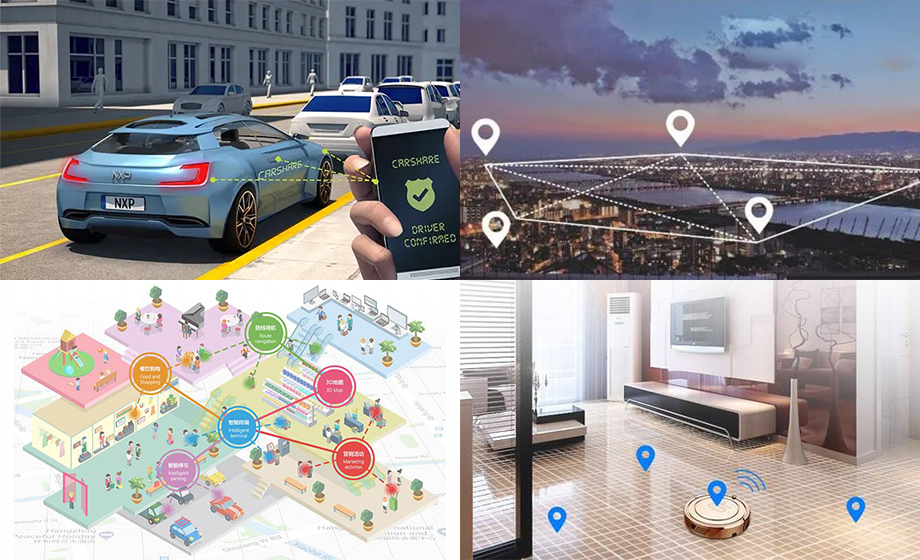Compared with other indoor positioning technology, uwb positioning module technology has 10 advantages. When it comes to positioning technology, people first think of GPS, because GPS has penetrated into our daily life, such as driving by car, visiting customers in unfamiliar places. However, the signal power of GPS is large, and the cost is expensive.

WiFi
Wi-Fi is a standardization organization for WLAN, and its devices follow the 802.11 protocol. From 1999 to several generations, from 802.11, 802.11B, 802.11A/G, 802.11N, 802.11AC, Wi-Fi has gradually been accepted by the majority of users. Now all smart phones integrate WiFi radio frequency, so the promotion of WiFi-based LBS has been gradually attracted by major manufacturers.
Broadcom has released a new chip (BCM4752) that can form an indoor three-dimensional positioning system, which is expected to be popularized and integrated into new smart phones soon. Qualcomm also introduced izat technology for indoor precise positioning, which it claims can be accurate to within 5 meters in most cases. Google's indoor positioning system uses WiFi positioning to determine the relative position of users and known WiFi hotspots and indoors through the perception of signal strength. The advantage of WiFi positioning is that there are many terminals. Now basically all smart phones, tablet computers and other devices are embedded with the function of WiFi.
BluetoothBLE
iBeacons are based on bluetoothle technology, the full name is bluetoothlowenergy, or ble for short. ble is mainly used in new smartphones. Bluetooth Low Energy was developed by Nokia in 2001 to develop a set of standards that would be compatible with standard Bluetooth and further optimize power consumption and manufacturing price. In 2004, Nokia released the Bluetooth Low Energy standard. In 2006, it appeared under the brand name of Wibree Technology. In 2007, it reached an agreement with the Bluetooth SIG, the Bluetooth SIG, and incorporated it into standard Bluetooth, officially named Bluetooth Low Energy. It has a working range of 45 meters.
Apple has two applications in promoting the technology, one for location services in shopping malls and the other for payment services.
Zigbee
Zigbee is a low-power LAN protocol based on the IEE802.15.4 standard. The technology specified in this agreement is a short-range, low-power wireless communication technology. It is characterized by close proximity, low complexity, self-organization, low power consumption, and high data rate. Mainly used in the field of automatic control and remote control, and can be embedded in various devices. The advantage of Zigbee positioning is low power consumption. In addition, Zigbee supports ad hoc networks, and its transmission channel is simpler. In China, Zigbee is widely used in coal mine positioning, prison personnel positioning, etc.
RFID (UHF)
RFID technology operating at 900MHz is mainly composed of passive tags and readers. The advantage is that it is passive at the tag end, which determines its very limited working distance. Generally, it can only reach 10 meters. The positioning of UHF technology can only solve the simple judgment of whether to enter a certain area, and then know the distance between the tag and the reader according to the signal strength fed back by the tag.
Ultra Wideband UWB
UWB (ULTraWideband) is a carrierless communication technology that transmits data using nanosecond to microsecond non-sinusoidal narrow pulses. The uwb positioning module modulates fast rising and falling pulses with NS-level pulse widths. The pulses cover the spectrum from DC to GHz and do not require the RF frequency translation required by traditional narrowband modulation. After the pulse is formed, it can be sent directly to the antenna for emission. The pulse peak interval is in the order of 10-100ps. The spectral shape can be tuned by very narrow continuous monopulse shape and antenna loading characteristics. The uwb positioning module signal is sparsely distributed on the time axis, and the power spectral density is quite low. RF can transmit multiple UWB signals simultaneously. UWB signals are similar to baseband signals and can use reflected pulse key control, pulse amplitude modulation, or pulse position modulation. Unlike traditional wireless systems that convert baseband signals into radio frequency (RF), UWB can be regarded as a baseband transmission scheme on RF. The uwb positioning module can accurately distinguish with multi-centimeter-level time accuracy. At present, the uwb positioning module management solution can be applied to scenarios with complex environments and closed spaces such as factories, chemicals, power plants, warehousing, justice, and underground construction.



